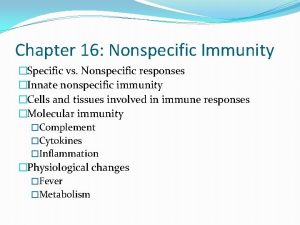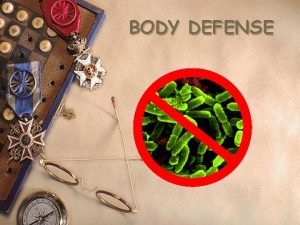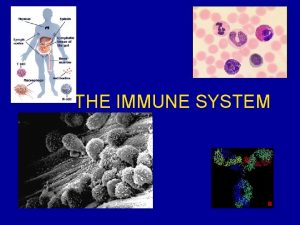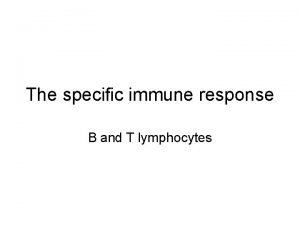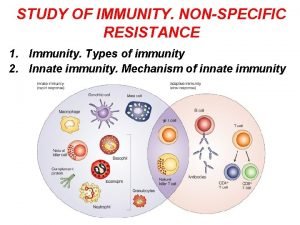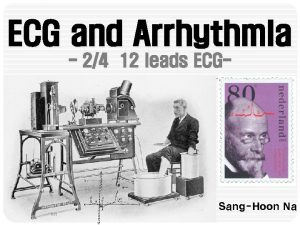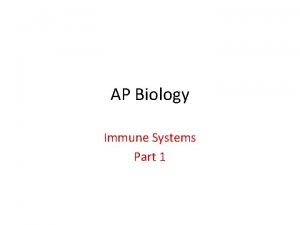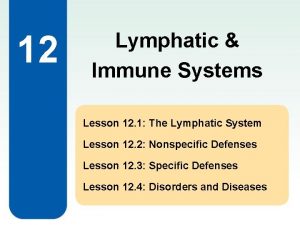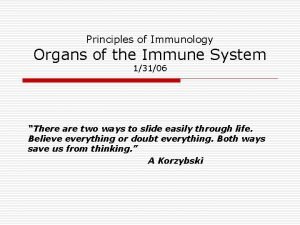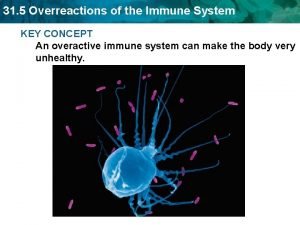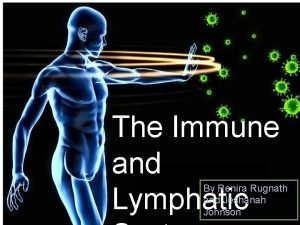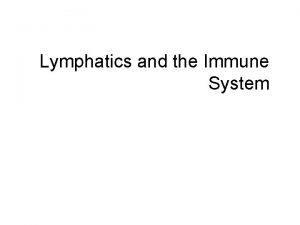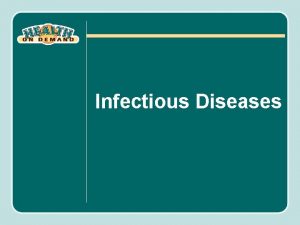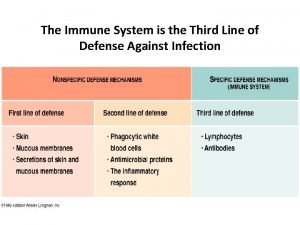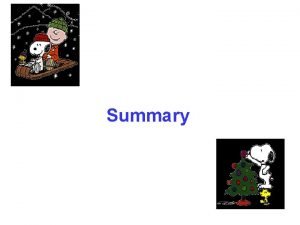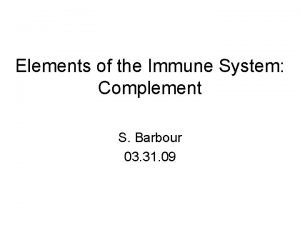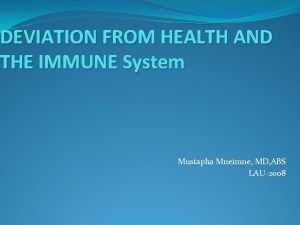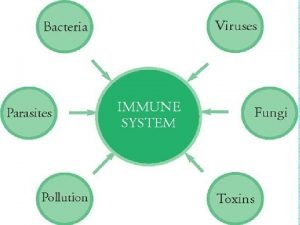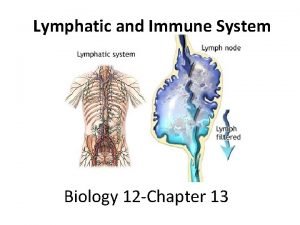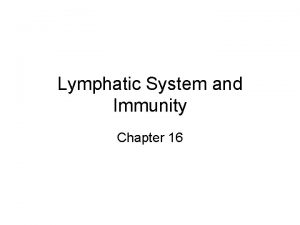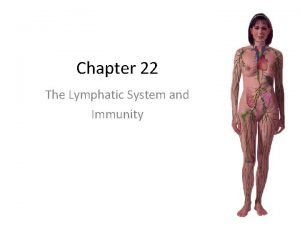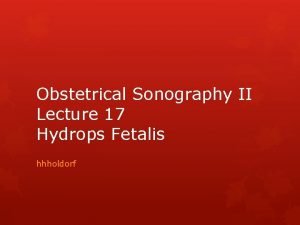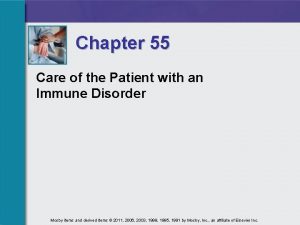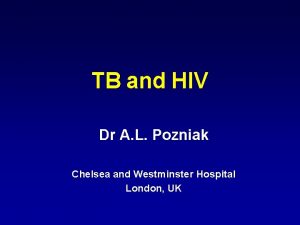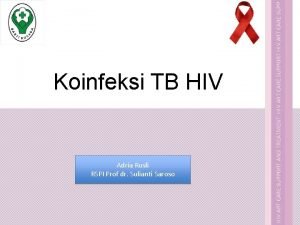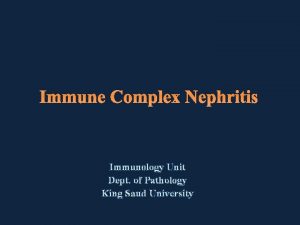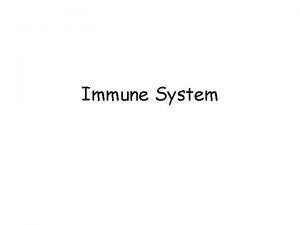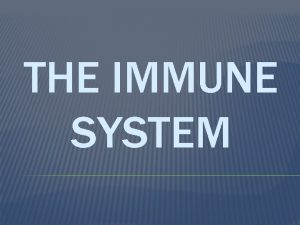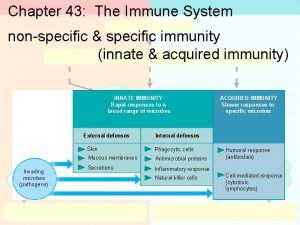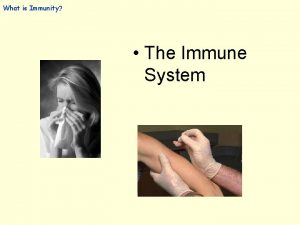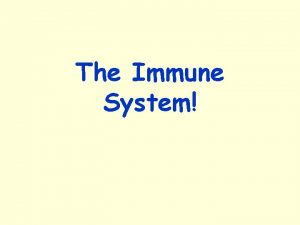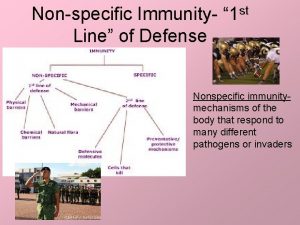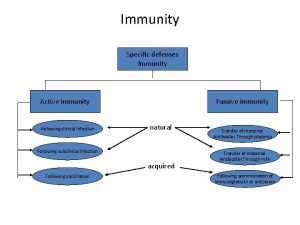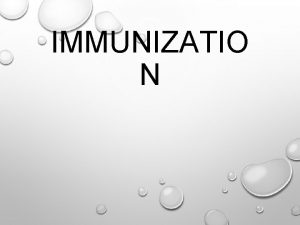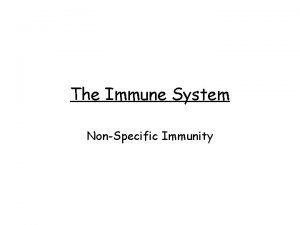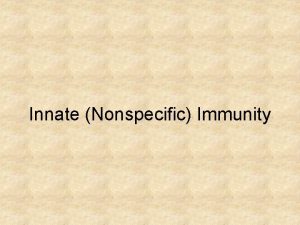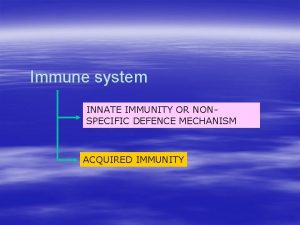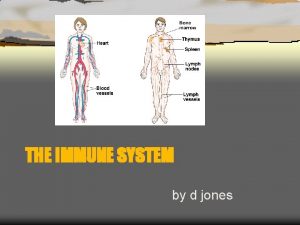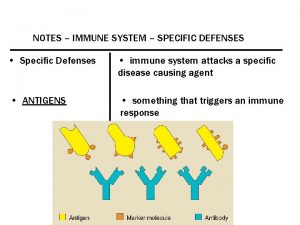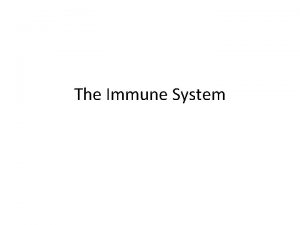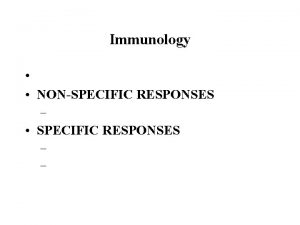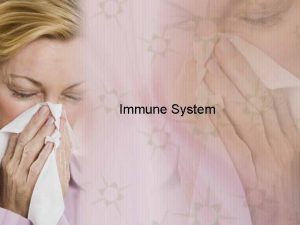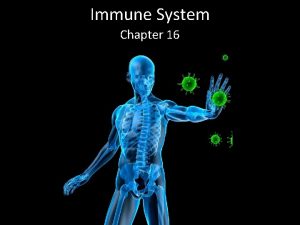Immune System A Dr Production Nonspecific Immunity Specific















































- Slides: 47

Immune System A Dr. Production

Nonspecific Immunity Specific Immunity Defense system

First line of defense: Surface membrane barriers • Skin and mucous membrane – Layered epidermis and shedding of epithelial cells – Sebum inhibits growth of bacteria and fungi – Mucous traps microbes, dust and pollutants. • • • Lacrimal apparatus Saliva Vaginal secretions Flow of urine Defecation and vomiting Gastric juices destroy bacteria and their toxins

Other 1 st Line Defenses Oral Cavity Antimicrobial enzymes in saliva (e. g. lysozyme and lactoperoxidase) inhibit microbes, Resident flora Skin p. H (3 -5), sebum Respiratory Cavity Hairs, cilia, mucociliary escalator, Sticky mucus (lysozyme) traps dust and microbes. GI Tract low p. H and digestive enzymes, flushing action Eyes Tears, (lysozyme). flushing action Vagina p. H, flushing action, resident flora

Second line of defense: chemical and cellular defenses • Antimicrobial proteins – Interferon – Complement • Natural killer cells • Phagocytes – Neutrophils – Dendritic cells – Macrophages • Wandering • Fixed – Eosinophils

Interferons • Produced by lymphocytes, macrophages and fibroblasts. • Interfere with translation of viral proteins • Degrade viral RNA • Activate macrophages and NK cells • = cytokine • Interferon Animation

Complement- plasma membrane protein control to destroy invading cells Uses + feedback Complement Cascade Animation

Phagocytosis, 2 Phagocytes - cells which "eat" foreign material to destroy them Phagocytes are formed from stem cells in bone marrow (stem cells are undifferentiated WBC's) Found in invertebrates • Neutrophil - phagocytize bacteria • Eosinophils - secrete enzymes to kill parasitic worms among other pathogens Macrophage - "big eaters" phagocytize just about anything

Phagocyte Mobilization

Inflammatory/Wound Site Response Acute Inflammation

Major Histocompatibility Complex • Normally your immune cells do not attack your own body tissues, which all carry the same pattern of self-markers • This set of unique markers on human cells is called the major histocompatibility complex (MHC). There are two classes: – MHC Class I proteins, are on all cells and activate cytotoxic T cells – MHC Class II proteins, are only on certain specialized cells and activate helper T cells

Natural Killer Cells • Unique to vertebrates • NK cells patrol the body, attaching to infecting cells presenting MHC I antigens but can recognize stressed cells & work in the absence of antibodies and MHC • release small granules of pp (perforin & granzyme = cytokines) that cause apoptosis in target cell – Cell Formation – NK Cell Interacting with a Virus-Infected Cell

Fever & Inflammatory response Inflammation Animation & Stages • Unique to vertebrates • Release of Chemical Alarms (histamines and cytokines) by Mast Cells • Vasodilation & Permeability of BV • Migration of phagocytes: Dispose cellular debris & pathogens • Prevent spread of damaging chemicals & pathogens – Signs of inflammation: Redness, Heat, Swelling, Pain, Impairment of function Fever • Regulated by hypothalamus, due to pyrogens secreted by leukocytes & macrophages • Causes liver and spleen to sequester zinc and iron • Increases metabolic rate (repair)

Adaptive (specific) Resistance • Specificity—recognition of particular antigens • Memory—remembers previously encountered antigens • Systemic—immunity is not restricted to the initial infection site • Immune responses – Antibody-mediated or humoral immune responses (late 1800 s) – Cell-mediated immune responses (mid 1900 s)


Cells of the Immune System Tutorial Leukocytes

T Lymphocytes • CD 4 T cell also known as a T Helper (Th) cell • CD 8 T cell also known as a Cytotoxic T (Tc) cell • Cellular Immune Reponses • Humoral Immune Response

Mechanisms of Cytotoxic T cells (TC) Action • Bind to the target cell and release perforin into its membrane • Secreting lymphotoxin, which fragments the target cell’s DNA • Releasing tumor necrosis factor (TNF), which triggers apoptosis • Secreting gamma interferon, which stimulates phagocytosis by macrophages • Similar to NKs, but need APCs or antigens to activate them

Mechanisms of T Helper (TH) Action • Once primed by APC presentation of antigen, they: – Chemically or directly stimulate proliferation of other T cells – Stimulate B cells that have already become bound to antigen • Without TH, there is no immune response • TH cells interact with B cells that have antigen fragments on their surfaces bound to MHC II receptors and to divide more rapidly and begin antibody formation • Cytokines released by TH amplify nonspecific defenses

Humoral (antibody-mediated) immune system Cellular (cell-mediated) immune system Control of freely circulating pathogens Control of intracellular pathogens Intracellular antigens are expressed on the surface of an APC, a cell infected by a virus, a bacterium, or a parasite. Extracellular antigens A B cell binds to the antigen for which it is specific. A T-dependent B cell requires cooperation with a T helper (TH) cell. T cell Cytokines activate T helper (TH) cell. Cytokines activate macrophage. Cytokines B cell The B cell, often with stimulation by cytokines from a TH cell, differentiates into a plasma cell. Some B cells become memory cells. Cytokines from the T H cell transform B cells into antibody-producing plasma cells. Plasma cells proliferate and produce antibodies against the antigen. Activation of macrophage (enhanced phagocytic activity). TH cell Cytotoxic T lymphocyte Plasma cell A T cell binds to MHC–antigen complexes on the surface of the infected cell, activating the T cell (with its cytokine receptors). Memory cell Some T and B cells differentiate into memory cells that respond rapidly to any secondary encounter with an antigen. Lysed target cell The CD 8+T cell becomes a cytotoxic T lymphocyte (CTL) able to induce apoptosis of the target cell.

Cells & Organs of the Immune System

Antigens and antigen receptors • Antigens can be entire microbes, parts of microbes or chemical components of pollen, egg white, blood cells • Plasma cells secrete specific antibody at the rate of 2000 molecules per second • Complement fixation is the main mechanism used against cellular antigens • Antibodies bound to cells change shape and expose complement binding sites • T Cell Dependent Antigens

MHC proteins & APCs • Antigens on our own cells are self-antigens • MHC proteins are glycoproteins that mark the cell as self. – Class I MHC proteins are on all body cells. Receptors on TC – Class II MHC proteins are only on certain cells that act in the immune response. Receptors on TH – Antigen Processing

Immunocompetence • Immature Lymphocytes = in bone marrow • T and B cells that have not been exposed to an antigen are naïve. • Binding with an antigen completes differentiation into functional B and T cells. • B cells mature in the bone marrow. • T cells mature in the thymus.

Clonal Selection Monoclonal Antibody Production

Mechanisms of Antibody Action

Antibodies “immunoglobulins”

Immunoglobulin classes • Ig. D is attached to B-cell plasma membrane • Ig. M is released during primary response. Indicates current infection. • Ig. G is the most aboundant. Can cross placenta & blood vessel walls. • Ig. A found in body secretions prevents attachment to body surfaces. • Ig. E causes release of histamine (allergies) by attaching to mast cells & basophils.

Immunological memory Primary vs Secondary Immune Response

Active Humoral Immunity • B cells encounter antigens and produce antibodies against them Passive Humoral Immunity • B cells not challenged by antigen • No immunological memory • Protection ends when antibodies naturally degrade in the body

dendritic cells, macrophages

Cell-mediated immunity • Antibodies can only inactivate an antigen and NOT destroy it. • Antibodies prepare an organism for destruction by innate defenses. • T cells can only recognize and respond to processed fragments of protein. • T cells are suited for cell to cell interaction and target body cells infected by virus, bacteria and abnormal or cancerous body cells or cells that are transplanted or infused. • Cells & Organs of the Immune System. Review & Quiz

Autoimmunity and Allergy • Autoimmunity diseases are produced by failure of the immune system to recognize and tolerate self-antigens, and can result from a variety of mechanisms. • Allergies can be divided into immediate hypersensitivity and delayed hypersensitivity, both of which can cause the release of histamine. • In extreme cases, the widespread release of histamine can lead to anaphylactic shock.

Hypersensitivities Hypersensitivity Reactions in the Skin

Hypersensitivities Acute Immediate Subacute cytotoxic Subacute Immune complex Delayed

Type I Hypersensitivity Animation Type II Hypersensitivity Type III Hypersensitivity

Essential knowledge 2. D. 4: Plants and animals have a variety of chemical defenses against infections that affect dynamic homeostasis. b. Mammals use specific immune responses triggered by natural or artificial agents that disrupt dynamic homeostasis. 1. The mammalian immune system includes two types of specific responses: cell mediated and humoral. 2. In the cell-mediated response, cytotoxic T cells, a type of lymphocytic white blood cell, “target” intracellular pathogens when antigens are displayed on the outside of the cells. 3. In the humoral response, B cells, a type of lymphocytic white blood cell, produce antibodies against specific antigens. 4. Antigens are recognized by antibodies to the antigen. Antigens & Epitopes, Antigen Processing 5. Antibodies are proteins produced by B cells, and each antibody is specific to a particular antigen. ABO Type II Sensitivity 6. A second exposure to an antigen results in a more rapid and enhanced immune response.

Essential knowledge 2. E. 1: Timing and coordination of specific events are necessary for the normal development of an organism, and these events are regulated by a variety of mechanisms. • Programmed cell death (apoptosis) plays a role in the normal development and differentiation. – Immune function LO 2. 29 The student can create representations and models to describe immune responses. LO 2. 30 The student can create representations or models to describe nonspecific immune defenses in plants and animals.

Essential knowledge 2. D. 4: Plants and animals have a variety of chemical defenses against infections that affect dynamic homeostasis. a. Plants, invertebrates and vertebrates have multiple, nonspecific immune responses. – Invertebrate immune systems have nonspecific response mechanisms, but they lack pathogen-specific defense responses. (phagocytes present in all animals, sponges can attack tissues from other sponges) – Plant defenses against pathogens include molecular recognition systems with systemic responses; infection triggers chemical responses that destroy infected and adjacent cells, thus localizing the effects. – Vertebrate immune systems have nonspecific and nonheritable defense mechanisms against pathogens.

Plant defenses against pathogens include molecular recognition systems with systemic responses; infection triggers chemical responses that destroy infected and adjacent cells, thus localizing the effects. PR pathogenesis related proteins

Essential knowledge 3. D. 2: Cells communicate with each other through direct contact with other cells or from a distance via chemical signaling. • a. Cells communicate by cell-to-cell contact. – Immune cells interact by cell-cell contact, and killer Tcells. Interaction of Antigen Presenting Cells and Thelper Cells – Essential knowledge 3. D. 4: Changes in signal transduction pathways can alter cellular response. • a. Conditions where signal transduction is blocked or defective can be deleterious, preventative or prophylactic. – Diabetes, heart disease, neurological disease, autoimmune disease, cancer, cholera

Epidermis: A Complex Plant Tissue - Covers and protects plant surfaces -Secretes a waxy, waterproof cuticle -In plants with secondary growth, periderm replaces epidermis -protection, increase absorption area in roots, reduces H 2 O loss in stem & leaves, -Regulates gas exchange in leaves Signaling between Plants and Pathogens

Plant Attack From Predators

Xenohormesis: Sensing the Chemical Cues of Other Species Many plant molecules interact with and modulate key regulators of mammalian physiology in ways that are beneficial to health, but why? We propose that heterotrophs (animals and fungi) are able to sense chemical cues synthesized by plants and other autotrophs in response to stress. These cues provide advance warning about deteriorating environmental conditions, allowing the heterotrophs to prepare for adversity while conditions are still favorable.

Antigen Shifting • A pathogen may escape recognition by the immune system if it changes its surface antigens. Such antigen shifting is an example of evolution by natural selection.

Immune-enhancing role of vitamin C and zinc and effect on clinical conditions. Wintergerst ES, Maggini S, Hornig DH. Ann Nutr Metab. 2006; 50(2): 85 -94. Epub 2005 Dec 21. • Vitamin C concentrations in the plasma and leukocytes rapidly decline during infections and stress. Supplementation of vitamin C was found to improve components of the human immune system such as antimicrobial and natural killer cell activities, lymphocyte proliferation, chemotaxis, and delayed-type hypersensitivity. Vitamin C contributes to maintaining the redox integrity of cells and thereby protects them against reactive oxygen species generated during the respiratory burst and in the inflammatory response. Likewise, zinc undernutrition or deficiency was shown to impair cellular mediators of innate immunity such as phagocytosis, natural killer cell activity, and the generation of oxidative burst. Therefore, both nutrients play important roles in immune function and the modulation of host resistance to infectious agents, reducing the risk, severity, and duration of infectious diseases.

Resources • • • • Components of the Immune System Animation The Body: The Immune System Chapter 17 - Adaptive Immunity: Specific Defenses of the Host Flash animation of a NK cell interacting with a normal body cell. Flash animation of a NK cell interacting with a virus-infected cell or tumor cell not expressing MHC-I molecules. Flash animation of apoptosis by NK cells. HIV Replication A&P Chapter 22: Lymphatic System and Immunity Blood & Body Defenses Notes Defense Mechanisms and the Immune System Introducing the Bloody Characters of Specific Immunity Adaptive Immunity in Prokaryotes Games Parasites Play Immune System notes Innate Immune System Unit 4 http: //lab. rockefeller. edu/steinman/interactive/dcell. html
 Nonspecific vs specific immunity
Nonspecific vs specific immunity Primary immune response and secondary immune response
Primary immune response and secondary immune response Difference between acquired immunity and innate immunity
Difference between acquired immunity and innate immunity Specific vs nonspecific defense
Specific vs nonspecific defense Specific defense vs nonspecific defense
Specific defense vs nonspecific defense схема імунної відповіді
схема імунної відповіді 3 proses produksi multimedia
3 proses produksi multimedia Non-specific immunity
Non-specific immunity Non specific innate immunity
Non specific innate immunity Nonspecific t wave abnormality
Nonspecific t wave abnormality Concave ekg
Concave ekg Nonspecific host defense mechanism
Nonspecific host defense mechanism What is the third line of defense in the immune system
What is the third line of defense in the immune system Blood cells flow chart
Blood cells flow chart Third line of defense immune system
Third line of defense immune system Innate immunity first line of defense
Innate immunity first line of defense Chapter 35 immune system and disease
Chapter 35 immune system and disease What is the third line of defense in the immune system
What is the third line of defense in the immune system Ap biology immune system
Ap biology immune system Lesson 12 blood and immune system
Lesson 12 blood and immune system Lesson 12 blood and immune system
Lesson 12 blood and immune system Immune system lymph nodes
Immune system lymph nodes Immune system definition
Immune system definition Overreactions of the immune system
Overreactions of the immune system Lymphatic vs immune system
Lymphatic vs immune system Lymphatic vs immune system
Lymphatic vs immune system Defination of tuberculosis
Defination of tuberculosis First line of defense
First line of defense The main function of immune system
The main function of immune system Malt
Malt Thymus
Thymus Immune complex
Immune complex Thalassemia autosomal recessive
Thalassemia autosomal recessive 1what's the purpose of the body's immune system?
1what's the purpose of the body's immune system? Chapter 13 lymphatic system and immunity
Chapter 13 lymphatic system and immunity Chapter 16 lymphatic system and immunity
Chapter 16 lymphatic system and immunity The lymphatic capillaries are
The lymphatic capillaries are Specific gravity of water formula
Specific gravity of water formula Plummet method specific gravity
Plummet method specific gravity Hydrops fetalis
Hydrops fetalis Active artificial immunity
Active artificial immunity Chapter 55 care of the patient with an immune disorder
Chapter 55 care of the patient with an immune disorder Chapter 24 the immune and lymphatic systems and cancer
Chapter 24 the immune and lymphatic systems and cancer Cancer vaccines
Cancer vaccines Immune reconstitution inflammatory syndrome
Immune reconstitution inflammatory syndrome Dr adria rusli
Dr adria rusli Immune complex glomerulonephritis
Immune complex glomerulonephritis Nct03946670
Nct03946670
